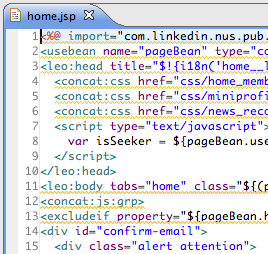[OSCON 2008] An Introduction to Ruby Web Frameworks by Ryan Carmelo Briones
Ryan is a Server Monkey / Code Sumari for Edgecase, LLC in Columbus, Ohio. A framework allows you to create re-usable code. Frameworks allow you to use encapsulation. Frameworks tend to be domain specific. For example, Rails works really for CRUD application, but not for others (i.e. Twitter).
Why Ruby?
Ruby has been Object Oriented since day 1. Ruby promotes Beautiful Code that's easy to read and maintain. Yes, MRI has performance issues. Matz has said "I'm a language designer" and has turned over the VM to others for Ruby 1.9. Another thing that might keep folks from using Ruby or its web frameworks is the libraries available. This is understandable, but it's being solved by alternative implementations. This includes YARV (the official 1.9 implementation), JRuby, IronRuby (not ready for production) and MagLev.
Rack
A framework that provides a minimal API for connecting web services and web frameworks. As a web application developer, this framework allows us to know about web services, but not worry about the details of talking to it. Below is a very simple Rack application.
class HelloWorld
def call(env)
[200, {"Content-Type" => "text/plain"}, ["Hello World!"]]
end
end
Rack allows the handlers do the work and not worry about the web server abstraction. Handlers exist for WEBrick, LightSpeed, Mongrel, Fast-CGI and many others. As an application developer, it allows you to choose different architectures (threaded, evented, etc.). Ryan is talking about Rack first because it's used in all the other Ruby web frameworks.
Ruby on Rails
Rails is 4 years old now and was written by DHH when he was a contractor at 37Signals. Rails doesn't define and grand new ideas, everything has been done before (MVC, code generation, etc.). What Rails did is package everything in a unique way that makes it very easy to use. Rails has influenced a lot of what has come from web frameworks in the last few years. One of Rails' nicest feature is code generation. Ryan showed part of DHH's Create a weblog in 15 minutes video to demonstrate code generation. He noted that the minute he showed was picked because David said "Whoops!" and "Look at all the things I'm not doing". Rails popularized Convention over Configuration using naming conventions and load paths. While this is definitely a cool feature, I think most web frameworks have adopted CoC by now. Maybe not JSF, but who wants to use JSF w/o a framework on top of it anyway?
One warning about Rails: "The Golden Path" can get in your way. Rails is very Opinionated Software and that's how Rails works. As long as you follow that, you should be very productivity. If you decide to go off the Rails (i.e. namespaces), it can be difficult.
Rails uses a DSL in its models (i.e. has_many, has_one for relationships) and in the Rails router. It allows you to very simply map a URL to a controller/method. In addition to DSLs, Rails has first-class testing and its generators create stub tests for you.
Bad things about Rails: too much magic, moves to fast (too many releases).
Merb
Merb was originally developed by Ezra Zygmuntowicz to run alongside a Rails app to handle file uploads. It grew from there and became it's own beast. Merb is very much about using only what you need. It has "package repos" that allow you to add additional features. For example, merb-core doesn't contain an ORM framework, just a web framework. Merb also allows you to choose your ORM. It's standardized on Rack, so it can run on just about any web server. It also included "deferred actions" that allow you to send some URLs to evented web servers and others to threaded web servers. Merb eschews the "magic" that Rails has. It tries to stay away from making it's code a "monument to personal cleverness". Simple code scales better and runs faster.
One of the downers to Merb is that it's flexibility allows you to get down to the nitty gritty. However, it can be less productive than Rails because of its flexibility. Another downside is its documentation and examples are sparse. Merb is not recommended if you're just getting into Ruby.
Camping
Camping is a micro framework (< 4K) developed by why the lucky stiff. It's designed to develop small applications. You can do everything in one file and create prototypes very quickly. It uses Markaby to write HTML code in a builder-style fashion.
Since a Camping application is all in one file, it can be difficult to develop large applications. The solution is to write small apps and mount them in the same URL space. The only issue with small apps sharing the same space is they have to use the same database. One downside to Camping is there is no standard test framework. Mosquito was developed as a solution, but doesn't seem to be maintained.
Sinatra
Simple. Fast. Effective. It's designed to allow creating REST applications with minimal dependencies. Similar to Camping, it has one file for the entire application. Unlike Camping, Sinatra doesn't follow MVC conventions, so it may be difficult to port a Sinatra application to another framework.


 At LinkedIn,
At LinkedIn, 



